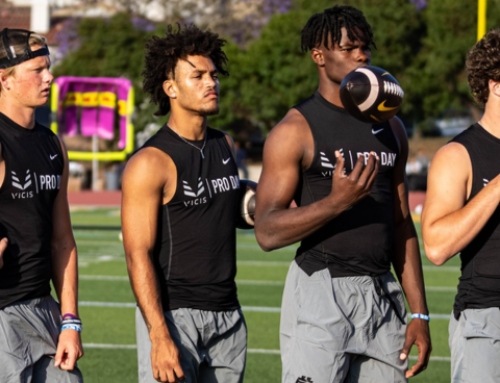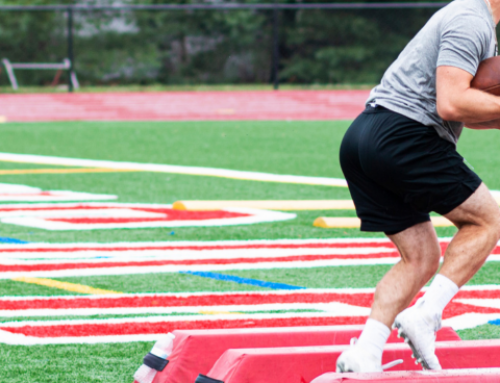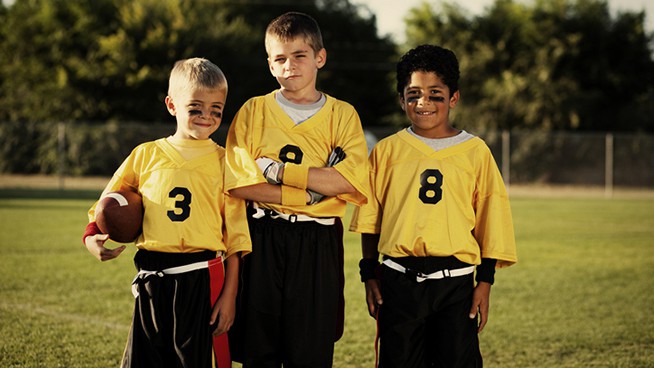Why D1 Football Players Are Training With the Triple Jump
Of all the athletic marvels the human body’s capable of, a world-class Triple Jump might be the most mind-boggling. An Olympic event since 1896, the Triple Jump sees athletes utilize a running start before executing a single-footed “hop, skip and jump” to fling themselves for distance into a sand pit. At the elite level, the result is something out of a comic book:
Crazy, right? Jonathan Edwards, the reigning world record-holder in the Triple Jump, once covered more than 60 feet. Think about that for a second. Imagine a football running back taking a hand-off at the 20-yard line and, within three foot strikes, scoring a touchdown.
The movement takes an absurd amount of power, coordination, balance and athleticism, and the forces at play are stunning. Not only do elite male triple jumpers hit speeds of up to 10.5 meters per second during their run-up, but research from Loughborough University found they can exert a force of up to 22 times their own body weight during the landing between the first and second jumps. Those types of actions are difficult to replicate inside a weight room, and there’s reason to believe team sport athletes can see serious benefit from integrating triple jump-style drills into their training.
Eric Donoval, Associate Director of Sport Performance for Wyoming Football, has done exactly that with his athletes this summer:
Cowboys looking springy this morning on STJ’s. Great test of power and elasticity that correlates well to acceleration ability #RaceHorsesVsPlowHorses #WYOspeed pic.twitter.com/3p0miNCQc9
— Eric Donoval (@edonoval) July 15, 2019
Those athletes are occasionally clearing 10 yards in distance from a standing start, which is no small feat. I’d never seen football players use a Triple Jump variation in training before I saw Donoval’s tweet, but at a glance, it makes perfect sense—it’s explosive, it’s unilateral, and, unlike many traditional weight room movements, it requires athletes to focus more on propelling themselves outward rather than upward. It seems to have many direct correlations to linear acceleration and speed. When I reached out to Donoval, he confirmed many of those suspicions.
“When you look at the triple jump specifically, they’re some of the most explosive, most powerful, most elastic athletes in track,” Donoval tells STACK.
“Some of these triple jumpers are really, really fast. So those qualities are something that, in my opinion, are very important for skill position players—the receivers, the DBs,” he said. “The Standing Triple Jump challenges coordination, it really increases power and elasticity in a unilateral fashion, which is really important for acceleration. The horizontal force vectors, the ground contact times that those movements have, really mimc and improve the qualities you need for acceleration. And it really improves the stiffness of the ankle-foot-and-hip complex, it teaches athletes to pre-load those legs to drive into the ground, and those are all a lot of the same things you’re going to see in some of the most elite accelerators.”
It is not an easy drill, and Donoval says the team spent many months gradually increasing the intensity of their plyometrics to build up to it. They’ve now been performing Standing Triple Jumps for several weeks, and he’s been amazed at the progress.
“(There’ve been) a lot of corrections we’ve had to make with the drill. It hasn’t been perfect by any means. The biggest thing we always have a problem with is guys being confident off that initial broad jump, because you’re landing on one leg instead of two,” Donoval says. “But once those coaching cues are kinda ingrained in their head, then they do self-organize and the competition takes over and we start seeing some of those 10-yard jumps.”
Those coaching cues include:
- Project yourself out at about a 45-degree angle with your jumps.
- Drive your knee up to waistband height.
- Utilize a low heel recovery.
- Strike the ground directly underneath your hip.
Coaches log the distance of every attempt and utilize cones to visually indicate benchmarks players should strive for. The benchmarks come directly from STACK expert Joel Smith’s book Speed Strength. Twenty-nine feet is considered a very good jump for a novice or intermediate collegiate athlete, while anything 32 feet and beyond is considered elite. The first week the team performed the drill, four Wyoming players were able to hit the 29-foot mark. By the end of week three, that number had ballooned to 16.
“Our guys love to compete. Anytime you’re going to pull up measuring sticks and you’re going to get everyone around and you’ve got eyes on you jumping, they’re going to compete and their intent gets a lot higher,” Donoval says.
“The improvements have been dramatic. The technique’s getting better, they’re getting more confident with it, and what comes with confidence is having better intent and better power off of each step…When you look at our 10s and 20s, and you look at the guys who can accelerate the best, those tend to be, for the most part, the guys that are getting the furthest on the Standing Triple Jump.”
Unlike the Olympic event, which begins with a running start, a Standing Triple Jump begins with a standing bilateral broad jump before two single-leg bounds. The standing version is a staple drill for real triple jumpers, too, who often practice it into a sand pit:
However, Donoval prefers having his athletes perform the drill on turf and to stick the landing.
“The qualities of the Triple Jump are important for football, but we have to understand they’re not triple jumpers. That’s why you see guys stick the landing instead of jumping into a sand pit or something,” Donoval says.
“A lot of injuries happen when your body is decelerating. Deceleration and the landing, in terms of football, is just as important as the jumping. Being able to absorb force is usually more important than being able to display force. We won’t advance (the drill) any more. Our goal now is just to get those (standing) triple jumps further rather than advancing the actual movement.”
Donoval uses the drill with Wyoming’s wide receivers, defensive backs and running backs, plus a few quarterbacks, fullbacks and linebackers. He does not recommend it for true linemen. A strong foot-and-ankle complex is required for good, technically-sound performance. “The forces that are applied to the foot during high-speed running, really 30-50 percent of the elastic return and the power generated comes from below the knee. So first and foremost, we gotta make sure these guys’ foot-and-ankle complex is extremely strong.”
Athletes will not exceed 15 total contacts in a given day on the Standing Triple Jump. Since each attempt includes three contacts, that means no more than five attempts in a workout. Athletes take 3-4 minutes of rest between each attempt.
“We started with just three reps, then move up to four, and the most we’re going to hit is five total,” Donoval says. “(And we give them) maximal rest. Less is always more when it comes to plyometrics and speed work, so we want these guys to be fresh.”
As the quest to create faster, more explosive football players continues, don’t be surprised to see proven track & field methods continue to bleed into the sport. Earlier this summer, we wrote about how Christian McCaffrey has seen remarkable results by taking more of a track-style approach in his training, and coach Tony Holler’s ‘Feed the Cats’ methodology continues to win pigskin converts.
“Football and track are very much related in terms of the qualities—especially in the skill positions—in what they do. In recruiting, we recruit these football players, and a lot of times, we look at their track times,” Donoval says.
“That’s very intriguing for collegiate football coaches who’re interested in the athletic abilities of some of these football players, but the problem lies sometimes when they get to college and we’re interested in these track times, yet we don’t train these qualities we’re recruiting in the first place.”
Photo Credit: Shaun Botterill/iStock
READ MORE:
RECOMMENDED FOR YOU
MOST POPULAR
Why D1 Football Players Are Training With the Triple Jump
Of all the athletic marvels the human body’s capable of, a world-class Triple Jump might be the most mind-boggling. An Olympic event since 1896, the Triple Jump sees athletes utilize a running start before executing a single-footed “hop, skip and jump” to fling themselves for distance into a sand pit. At the elite level, the result is something out of a comic book:
Crazy, right? Jonathan Edwards, the reigning world record-holder in the Triple Jump, once covered more than 60 feet. Think about that for a second. Imagine a football running back taking a hand-off at the 20-yard line and, within three foot strikes, scoring a touchdown.
The movement takes an absurd amount of power, coordination, balance and athleticism, and the forces at play are stunning. Not only do elite male triple jumpers hit speeds of up to 10.5 meters per second during their run-up, but research from Loughborough University found they can exert a force of up to 22 times their own body weight during the landing between the first and second jumps. Those types of actions are difficult to replicate inside a weight room, and there’s reason to believe team sport athletes can see serious benefit from integrating triple jump-style drills into their training.
Eric Donoval, Associate Director of Sport Performance for Wyoming Football, has done exactly that with his athletes this summer:
Cowboys looking springy this morning on STJ’s. Great test of power and elasticity that correlates well to acceleration ability #RaceHorsesVsPlowHorses #WYOspeed pic.twitter.com/3p0miNCQc9
— Eric Donoval (@edonoval) July 15, 2019
Those athletes are occasionally clearing 10 yards in distance from a standing start, which is no small feat. I’d never seen football players use a Triple Jump variation in training before I saw Donoval’s tweet, but at a glance, it makes perfect sense—it’s explosive, it’s unilateral, and, unlike many traditional weight room movements, it requires athletes to focus more on propelling themselves outward rather than upward. It seems to have many direct correlations to linear acceleration and speed. When I reached out to Donoval, he confirmed many of those suspicions.
“When you look at the triple jump specifically, they’re some of the most explosive, most powerful, most elastic athletes in track,” Donoval tells STACK.
“Some of these triple jumpers are really, really fast. So those qualities are something that, in my opinion, are very important for skill position players—the receivers, the DBs,” he said. “The Standing Triple Jump challenges coordination, it really increases power and elasticity in a unilateral fashion, which is really important for acceleration. The horizontal force vectors, the ground contact times that those movements have, really mimc and improve the qualities you need for acceleration. And it really improves the stiffness of the ankle-foot-and-hip complex, it teaches athletes to pre-load those legs to drive into the ground, and those are all a lot of the same things you’re going to see in some of the most elite accelerators.”
It is not an easy drill, and Donoval says the team spent many months gradually increasing the intensity of their plyometrics to build up to it. They’ve now been performing Standing Triple Jumps for several weeks, and he’s been amazed at the progress.
“(There’ve been) a lot of corrections we’ve had to make with the drill. It hasn’t been perfect by any means. The biggest thing we always have a problem with is guys being confident off that initial broad jump, because you’re landing on one leg instead of two,” Donoval says. “But once those coaching cues are kinda ingrained in their head, then they do self-organize and the competition takes over and we start seeing some of those 10-yard jumps.”
Those coaching cues include:
- Project yourself out at about a 45-degree angle with your jumps.
- Drive your knee up to waistband height.
- Utilize a low heel recovery.
- Strike the ground directly underneath your hip.
Coaches log the distance of every attempt and utilize cones to visually indicate benchmarks players should strive for. The benchmarks come directly from STACK expert Joel Smith’s book Speed Strength. Twenty-nine feet is considered a very good jump for a novice or intermediate collegiate athlete, while anything 32 feet and beyond is considered elite. The first week the team performed the drill, four Wyoming players were able to hit the 29-foot mark. By the end of week three, that number had ballooned to 16.
“Our guys love to compete. Anytime you’re going to pull up measuring sticks and you’re going to get everyone around and you’ve got eyes on you jumping, they’re going to compete and their intent gets a lot higher,” Donoval says.
“The improvements have been dramatic. The technique’s getting better, they’re getting more confident with it, and what comes with confidence is having better intent and better power off of each step…When you look at our 10s and 20s, and you look at the guys who can accelerate the best, those tend to be, for the most part, the guys that are getting the furthest on the Standing Triple Jump.”
Unlike the Olympic event, which begins with a running start, a Standing Triple Jump begins with a standing bilateral broad jump before two single-leg bounds. The standing version is a staple drill for real triple jumpers, too, who often practice it into a sand pit:
However, Donoval prefers having his athletes perform the drill on turf and to stick the landing.
“The qualities of the Triple Jump are important for football, but we have to understand they’re not triple jumpers. That’s why you see guys stick the landing instead of jumping into a sand pit or something,” Donoval says.
“A lot of injuries happen when your body is decelerating. Deceleration and the landing, in terms of football, is just as important as the jumping. Being able to absorb force is usually more important than being able to display force. We won’t advance (the drill) any more. Our goal now is just to get those (standing) triple jumps further rather than advancing the actual movement.”
Donoval uses the drill with Wyoming’s wide receivers, defensive backs and running backs, plus a few quarterbacks, fullbacks and linebackers. He does not recommend it for true linemen. A strong foot-and-ankle complex is required for good, technically-sound performance. “The forces that are applied to the foot during high-speed running, really 30-50 percent of the elastic return and the power generated comes from below the knee. So first and foremost, we gotta make sure these guys’ foot-and-ankle complex is extremely strong.”
Athletes will not exceed 15 total contacts in a given day on the Standing Triple Jump. Since each attempt includes three contacts, that means no more than five attempts in a workout. Athletes take 3-4 minutes of rest between each attempt.
“We started with just three reps, then move up to four, and the most we’re going to hit is five total,” Donoval says. “(And we give them) maximal rest. Less is always more when it comes to plyometrics and speed work, so we want these guys to be fresh.”
As the quest to create faster, more explosive football players continues, don’t be surprised to see proven track & field methods continue to bleed into the sport. Earlier this summer, we wrote about how Christian McCaffrey has seen remarkable results by taking more of a track-style approach in his training, and coach Tony Holler’s ‘Feed the Cats’ methodology continues to win pigskin converts.
“Football and track are very much related in terms of the qualities—especially in the skill positions—in what they do. In recruiting, we recruit these football players, and a lot of times, we look at their track times,” Donoval says.
“That’s very intriguing for collegiate football coaches who’re interested in the athletic abilities of some of these football players, but the problem lies sometimes when they get to college and we’re interested in these track times, yet we don’t train these qualities we’re recruiting in the first place.”
Photo Credit: Shaun Botterill/iStock
READ MORE:











